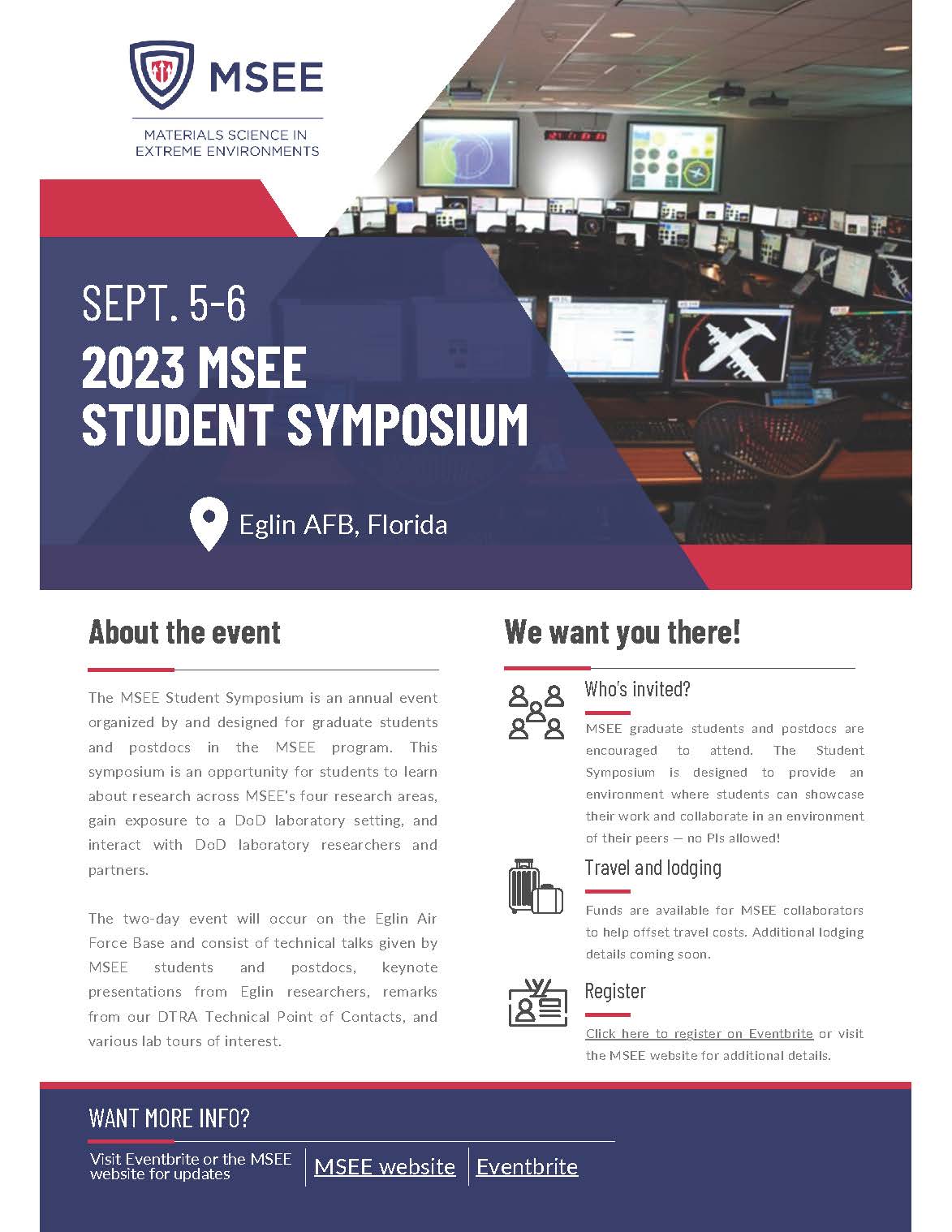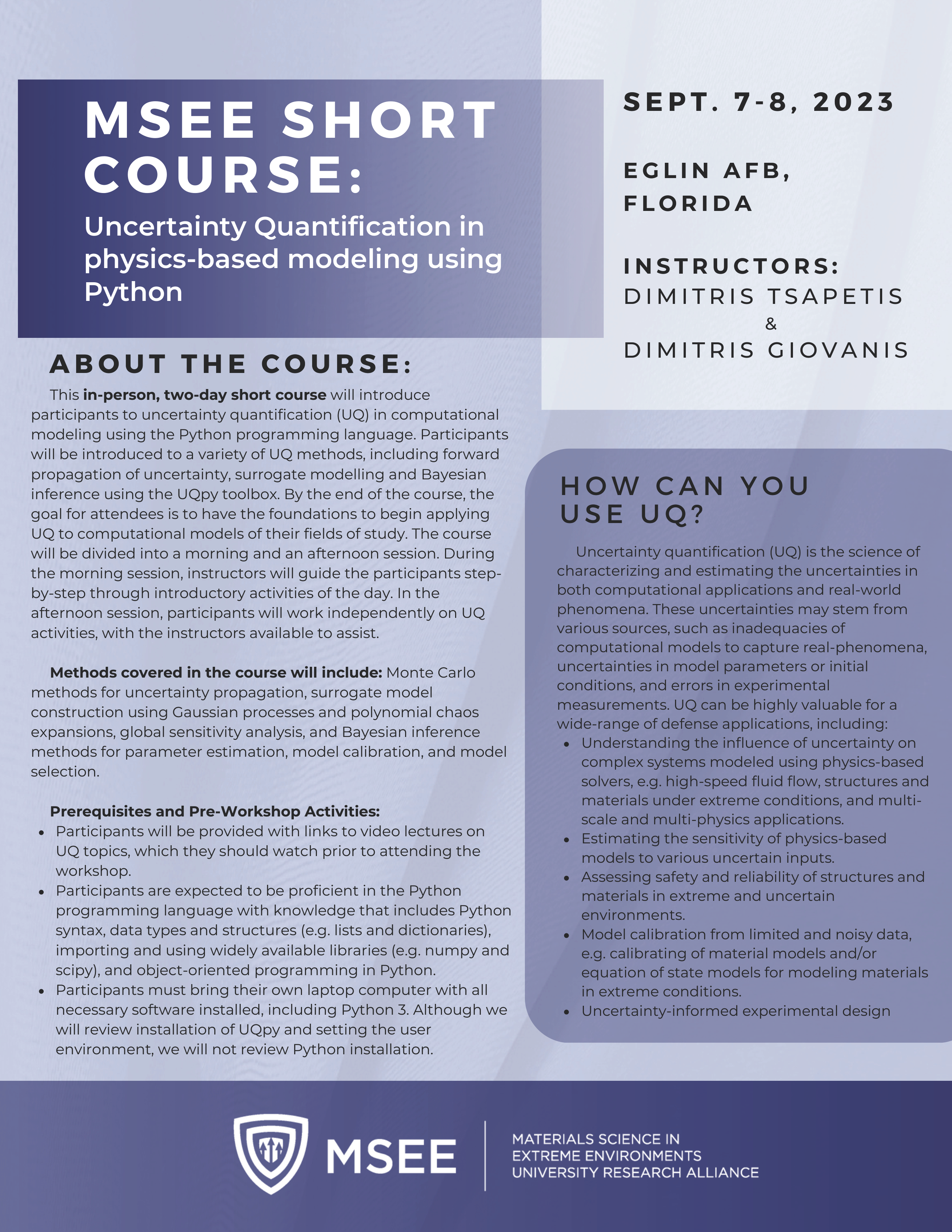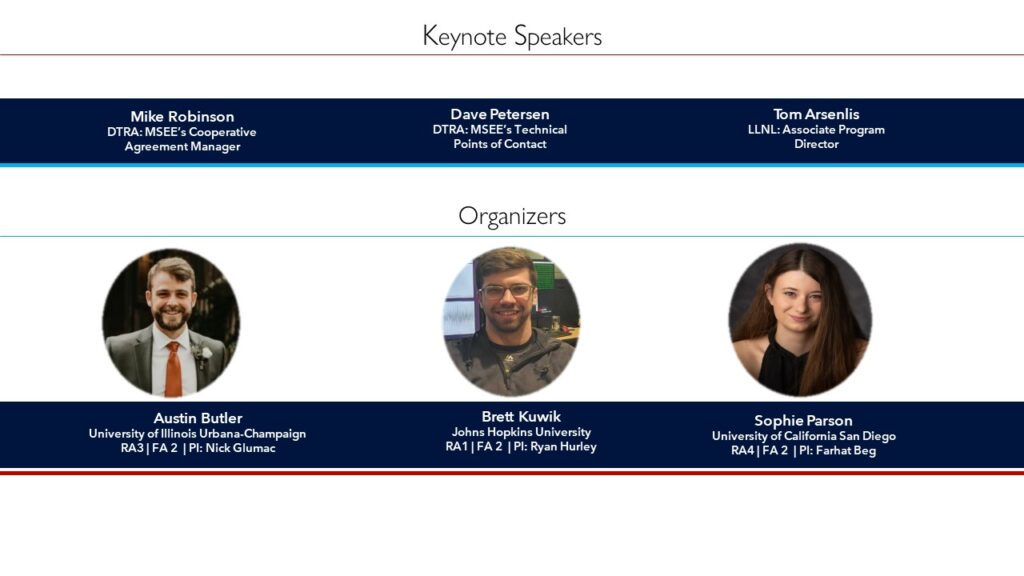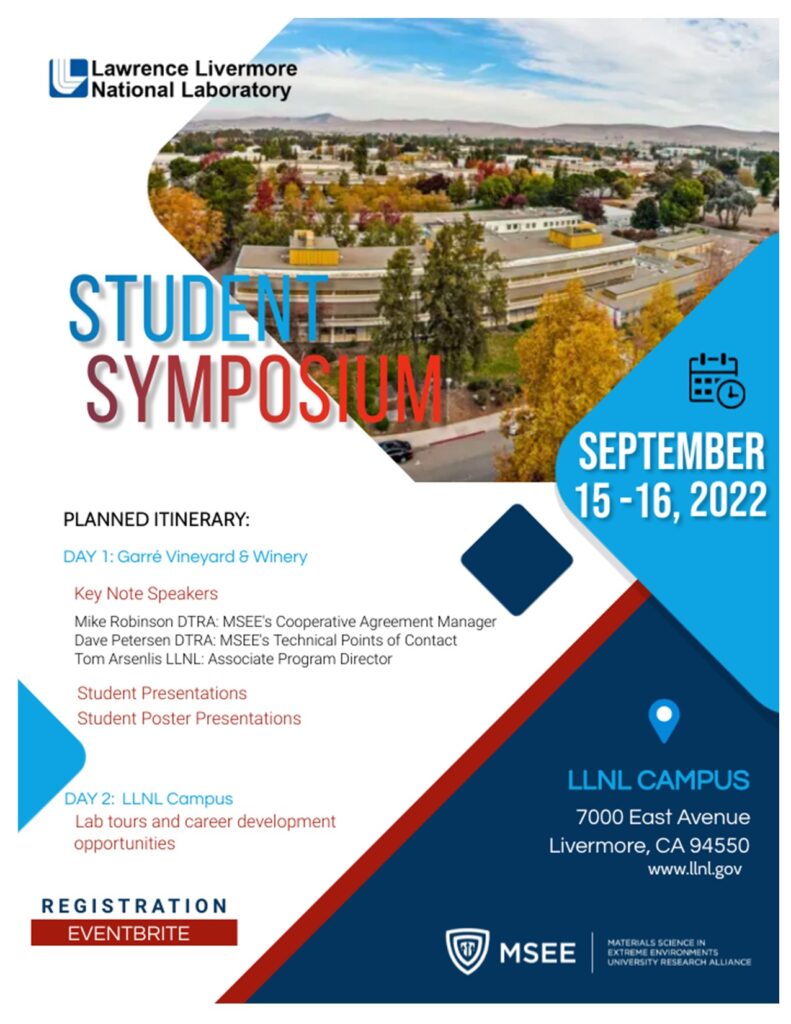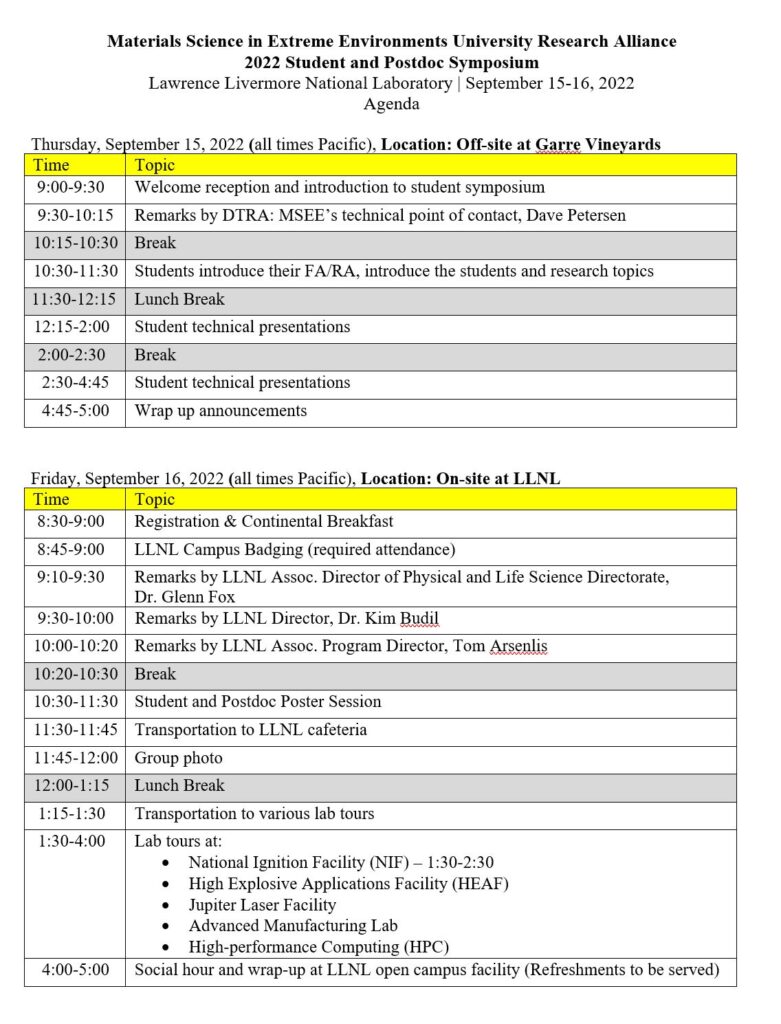2025 Annual Technical Review
Dates: June 25 - 27, 2025
The Defense Threat Reduction Agency (DTRA) uses the Annual Technical Review to review the progress of the MSEE URA. This meeting also provides a forum for the government and corporate affiliates program (GCAP) and science advisory board (SAB) to view the MSEE research activities. As we enter the final program year of our base period, this technical review will provide a culmination of progress and results since the start of MSEE. Each MSEE principal investigator (PI) will present their technical progress and accomplishments followed by a short question/answer period. This meeting is open to DTRA, MSEE PIs and their graduate students and postdoctoral fellows, and GCAP and SAB members.
MSEE PIs (or a designated representative) are required to prepare and present a poster on each of their research tasks. Poster sessions will occur during the afternoon of days 1 and 2 of the Annual Technical Review.
VENUE
The 2025 Annual Technical Review will take place at the Hopkins Bloomberg Center in Washington, D.C. 555 Pennsylvania Ave NW, Washington, D.C. 20001.
EVENT REGISTRATION
The Annual Technical Review is open to member of the MSEE community (PIs, students/postdocs, DTRA, GCAP, & SAB) and other sanctioned guests. Invitations will be sent out in December 2024. Click this link to register for the ATR.
AGENDA
The agenda for this event is currently in progress. The latest draft of this agenda can be found here.
EVENT LODGING
Rooms have been reserved for this event at the Arlo Washington DC at a group rate of $249.00 per night. The deadline to reserve rooms is June 5. Reservations can be made by clicking this link.
TRAVEL
The directions to get to the Hopkins Bloomberg Center may be found HERE
Car
We’re located at 555 Pennsylvania Ave., NW Washington, D.C. 20001. Input our address into your GPS and follow the directions. Paid street parking is available and several parking garages are located within walking distance of our building.
Metro
Our building is a short walk from five different metro stations, accessed best by the Red, Yellow, Orange and Green lines.
- Archives Navy Memorial-Penn Quarter Station (Green and Yellow Lines) — 4-minute walk
- Gallery Place-Chinatown Station (Green, Yellow and Red Lines) — 12-minute walk
- Federal Triangle Station (Blue, Orange and Silver Lines) — 13-minute walk
- L’Enfant Plaza Station (Orange, Blue, Silver, Green and Yellow Lines) — 13-minute walk
- Judiciary Square Station (Red Line) — 14-minute walk
Bus
The 32, 33, 36, 70, and P6 bus routes pass by our location. Several bus stops are located within walking distance of our main entrance.
Train
Amtrak, MARC, and VRE riders can take the train to Union Station and walk about 20 minutes to our building. You can also transfer to a bus or the metro.
Airplane
We’re located 20 minutes from Ronald Reagan Washington National Airport and about an hour from Dulles International Airport and Baltimore/Washington International Thurgood Marshall Airport. Traffic in Washington D.C. can be unpredictable, so be sure to plan accordingly.
POINT OF CONTACT
If you have a question or need to speak with a member of the MSEE team, please contact us at mseeura@jhu.edu.
WMD Risk Reduction Science and Policy Forum
For more information about this event, please visit the event website here.
June 23-24, 2025At a time when the potential use of chemical, biological, radiological, and nuclear weapons is of increasing concern, efforts to reduce risk take on increased urgency. Basic and applied scientific research programs have important roles to play in facilitating risk reduction and nonproliferation efforts, for example through the development of improved technologies to verify compliance with negotiated agreements.
This forum, hosted by Johns Hopkins University, will bring together science and policy experts. Topics include verification and monitoring, counter-WMD technologies, and mitigation of WMD effects, and role of emerging technologies such as artificial intelligence in risk reduction. The forum will feature plenary talks by subject matter experts and policymakers, panel discussions, and extensive opportunities to discuss the importance of scientific advances in support of risk reduction policy.
The Risk Reduction Science and Policy Forum is offered by Johns Hopkins University, in collaboration with the Materials Science in Extreme Environments University Research Alliance (MSEE URA), which is supported by the Defense Threat Reduction Agency.
ORGANIZING COMMITTEE:- Prof. Gigi Gronvall, Sr. Scholar, Center for Health Security, Bloomberg School of Public Health
- Prof. Todd Hufnagel, Assoc. Director, MSEE URA, Whiting School of Engineering
- Prof. Jane Vaynman, Asst. Prof. of Strategic Studies, School of Advanced International Studies
- Prof. Tim Weihs, Director, MSEE URA, Whiting School of Engineering
Workshop on Applied Machine Learning and Computer Vision for Automated Analysis
- Day 1:
- Lecture 1: Introduction to DCNNs
- Lecture 2: Object detection
- Lecture 3: Object segmentation
- Day 2:
- Lecture 4: Generative AI
- Lecture 5: Image restoration
- Lecture 6: Latest applications in AI
2024 MSEE Student Symposium
- Day 1: Off-site for all participants at Water's Edge Events Center. 4687 Millennium Dr, Belcamp, MD 21017
- Day 2: On-site for US Citizens ONLY at DEVCOM CBC. (Additional details of gathering for other participants TBD)
The MSEE Student Symposium is an annual event organized by and designed for graduate students and postdocs in the MSEE program. This symposium is an opportunity for students to learn about research across MSEE's four research areas, gain exposure to a DoD laboratory setting, and interact with DoD laboratory researchers and partners.
This two-day event will occur at the U.S. Army Combat Capabilities Development Command Chemical Biological Center (DEVCOM CBC) and consist of technical talks given by MSEE students and postdocs, keynote presentations from DEVCOM CBC and Army Research Laboratory researchers, and various lab tours of interest.
Full agenda details coming soon! LODGING Several lodging options are available in the area. These include the Inn at the Colonnade, The Study at Johns Hopkins, and others.2024 Annual Technical Review
- A professional development networking session led by former Acting and Deputy Director of DTRA, Major General Randy Manner. This professional development session is only available to MSEE students and postdocs. Additional details can be found here. Professional Development Session Details
- A networking session open to all other ATR attendees with opportunities for breakout groups by Research Area and Focus area.

